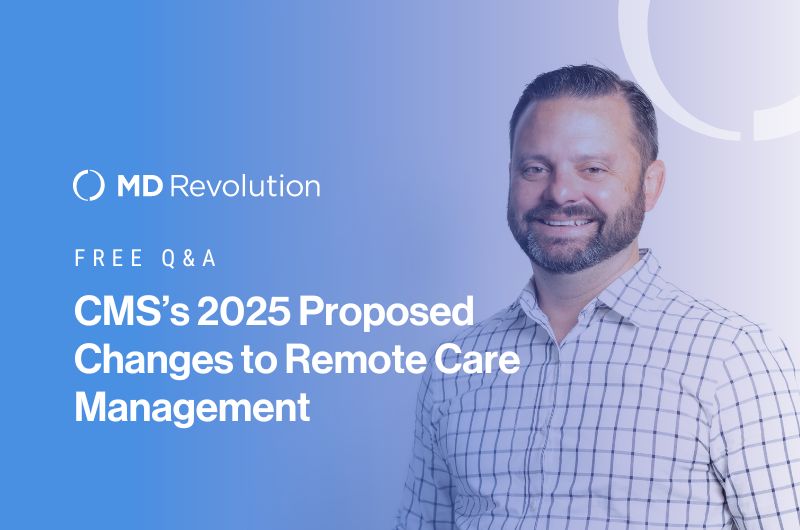With Paul Huffman, Chief Revenue Officer, MD Revolution
Paul has spent over 20 years working in healthcare and over a decade in the remote care industry. His experience specializing in the intersection of patient care and technology within outpatient clinics and health systems provides a unique and informed perspective. In a recent interview, he spoke in detail about these changes and what our landscape could look like in 2025.
Q: What are the main points of the proposed CMS Physician Fee Rules for 2025?
A: We are extremely excited about the proposed rule changes. We believe they align incentives with intended services and outcomes. The proposed rule for 2025 devotes considerable attention to formalizing a stronger emphasis on accountable and value-based care. Overall, there are many broad strokes to enhance the scope for remote care, with some yet to be determined implications.
Key changes include:
- Introduction of the Advanced Primary Care Management (APCM) model and a new set of HCPCS G-codes. The new codes focus on actions and offerings for patients while removing “time-based” requirements for providers
- Significant revision of recent RPM and CCM expansion for FQHC and RHC G-codes
- Proposed permanence for audio-only telehealth; extended virtual direct supervision policies
- New coverage for Digital Mental Health Treatment (DMHT); cross walked to existing RTM codes
- Updates to cardiovascular risk assessment offerings
- Recommendations for social needs services (e.g., Social Determinants of Health Assessments, Community Health Integration, Principal Illness Navigation)
Q: Which facets of the proposal should providers pay most attention to?
A: That depends on your care setting, what you’ve already offered to patients remotely, and specialty. But the biggest shift I see is incentive for primary care to adopt care management through more of a value-based care model, vs. fee for service. Chronic care management services are still underutilized under FFS, so CMS is attempting to encourage and expand the use of CCM through new Advanced Primary Care Model (APCM) services. For CY 2025, the proposal introduces new coding and payment for APCM, categorized by three new HCPCS G-codes, which significantly, are not time-based. The codes are stratified based on the patient’s chronic conditions and social complexity.
Potentially, starting January 1, 2025, physicians and NPs using advanced primary care models can bill for APCM services if they oversee all the patient’s primary care needs. The new coding aims to better support advanced primary care services, simplify billing, and encourage practice transformation.
Q: This would be a huge expansion of primary care services and reimbursement, but what’s the difference between ACPM services and already established care management codes?
A: Each APCM code requires 13 service elements, many of which combine elements of existing care management and technology services like PCM, TCM, and CCM, into a comprehensive bundle. Because CMS sees those service codes as “substantially duplicative” of APCM services, they cannot be billed simultaneously, though the APCM codes can be billed in conjunction with RPM. Every service element must be “available” to patients, but not all service elements need to be provided each month.
CMS indicates that the codes are intended primarily for primary care specialties such as general medicine, family medicine, internal medicine and pediatrics. However, also significant is that CMS anticipates that the APCM codes could potentially be billed for every patient of a primary care practice. Only 1 of the 3 codes – GPCM3, has a requirement that the patient be a Qualified Medicare Beneficiary.
Q: How will CMS measure the APCM model’s performance?
A: This is a tremendous shift in care delivery, and CMS recognizes that it will take time to gather learnings. There will be a performance measurement requirement, tied to the Value in Primary Care MIPS Value Pathway (MVP), that would begin in 2026. Until then, forward-thinking primary care providers have an incredible opportunity to reshape the way care is delivered and will likely have some say in what those requirements will look like.
Q: Can you explain the telecommunications service provisions aspect of the proposed rule?
A: CMS is proposing permanent coverage for bidirectional, real-time, audio-only telehealth services, which is great news for both patients and providers. This is specifically for “…any telehealth service furnished to a beneficiary in their home if the distant site physician or practitioner is technically capable of using an interactive telecommunications system, but the patient is not capable of, or does not consent to, the use of video technology.”
CMS would continue to allow direct supervision for non-behavioral health visits via video telecommunications and real-time audio-only through December 31, 2025. CMS is also proposing to delay the in-person visit requirement for mental health services provided via telecommunication until January 1, 2026. These continued extensions are good news, while many eagerly await (or preferably advocate) these changes to have permanence.
Q: How does the proposed rule impact Remote Therapeutic Monitoring services?
A: CMS included an extensive section on digital therapeutics in behavioral health care, proposing three new codes for digital mental health treatment devices such as digital therapeutics. However, it remains uncertain if these new codes would significantly alter the current framework. What we do know is that these codes would be cross walked to existing remote therapeutic monitoring codes 98980 and 98981.
Q: How do these rules differ from the past for FQHCs and RHCs?
A: In 2024, RHCs and FQHCs were given a groundbreaking opportunity to implement both RPM and Chronic Care Management (CCM) with proper compensation. Providers are now able to bill G0511 multiple times depending on patient need. This includes vital monitoring and health coaching, greatly expanding patient care options.
In 2025, it’s proposed that instead of having a unique code and reimbursement rate, FQHC and RHC providers will now use existing care management CPT codes for Medicare’s remote patient monitoring and chronic care management. Proposed payments would be at the national non-facility Medicare payment rate.
Q: What do you think is the motivation behind the dissolution of G0511? What impact will the coding structure and payment rate change have on FQHCs and RHCs that are already executing RPM and CCM programs?
A: CMS has expressed the need for greater transparency and payment accuracy for FQHCs and RHCs when furnishing these services and allow patient beneficiaries to better understand which services they are receiving. There have also been rumblings that even though patients at FQHCs and RHCs are more likely to need add-on care management time, the current coding scheme has incentivized providers to limit time to 20 minutes per patient, per month. Although we have not seen either of these challenges emerge within our FQHC and RHC client base, it’s clear that the issues are widespread, hence why CMS is seeking comment on the payment policy for care coordination services.
The payment structure change will impact the revenue streams of FQHCs and RHCs already furnishing these services with the higher reimbursed G0511 code, especially regionally due to Medicare’s geographic price index. Optimistically, however, while FQHCs and RHCs would have a lower floor for prospective payments, their ceiling on for billing RPM and CCM add-on codes would be higher. And, if the APCM codes are adopted, these revenue streams may vastly reward FQHCs and RHCs for their core primary care services.
Q: For FQHCs and RHCs that haven’t yet explored remote care, what advice would you give them?
A: The ideal time to act was Jan. 1, 2024, but if you haven’t, the time is as soon as you can say yes. Our programs are designed to ease staff workload, the heavy lifting is ours. Time for implementation should not be a barrier to entry into these services. The billing complexities are not going away, but there are remote care organizations, including ourselves, that are built to manage these complexities. What the proposed rules tell me is that it’s more important than ever to have an experienced partner to help you navigate.
It’s very important to note that even if the proposed changes are enacted, RPM and CCM codes are still very lucrative opportunities for reimbursement, for care your clinic is already providing. Remote care management is a win-win, regardless of the code associated with care delivery.
Q: Do you view these developments as positive for the future of remote care?
A: Overall, yes. Some of these changes are obvious wins, paving the way for more patient-focused, tailored healthcare delivery models. The APCM codes seem to have more and more positive implications than even at first glance. Since APCM codes are not time-based, for example, they would allow for the use of AI technologies to automate certain care management tasks, enabling practitioners and clinical staff to focus their clinical expertise where it is most needed and operate at the full scope of their licensure.
With major changes every year, it’s clear that Medicare values remote care management as a crucial element within our system of care. But it’s also obvious that they’re still working out the kinks with what works best for each patient population type, and how to appropriately compensate providers for care delivery. Unfortunately, organizations that need it most – FQHCs and RHCs, are seemingly always the last to be allowed to jump on policy improvements or the changes have unique implications.
Q: Any advice for how to best prepare for CMS rules in 2025?
A: Be an advocate, find an experienced partner and don’t hesitate. The proposal sought comments on potential additional payment policies through an Advanced Primary Care Hybrid Payment RFI, and several other code-specific RFIs. Those who have experienced remote care in its current state had an obligation to provide real-world insights and advocate for what’s to come. When the rule is finalized in November, advocacy and feedback is still warranted, and needed.
Secondly, finding an experienced partner that can flex and adapt to ever changing CMS regulations is more important than ever.
We have always delivered a task-based approach to the clinical delivery services we provide. This philosophy, and workflow, allows us to focus on what is available to, and completed for, each of our patients. Providers can specifically see what has been completed throughout the patient’s journey and track completed tasks from an analytics
and reporting perspective. Care gaps can be assigned to care team members and closures of those gaps can be reported. We can tie specific actions to outcomes and monitor progress. This allows us to focus on what actions work for patients instead of how many minutes were spent.
We’ve invested heavily into both our software and clinical services models to prepare for this juncture in care delivery, and it allows us to match our clients with our best fit solution.
Lastly, we’re seeing unprecedented shifts in our industry and there is no room for delay. Remote care strategies will zig and zag, but they are here to stay, and thankfully so. I encourage providers to hop on the train.
For more information or to discuss how these changes can benefit your practice, get in touch with us.




